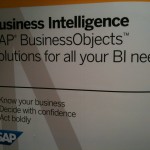 In a recent article, I shared my belief that SAP is phasing out the BusinessObjects brand (see Whistling Past the Brand Graveyard with BusinessObjects). A few weeks later, ASUG News included the following quote in a piece entitled “SAP BI 4.0 Launch: Still Counting Down to GA“ from John Schweitzer, SVP of Business Analytics for SAP North America:
In a recent article, I shared my belief that SAP is phasing out the BusinessObjects brand (see Whistling Past the Brand Graveyard with BusinessObjects). A few weeks later, ASUG News included the following quote in a piece entitled “SAP BI 4.0 Launch: Still Counting Down to GA“ from John Schweitzer, SVP of Business Analytics for SAP North America:
As to the future of the BusinessObjects brand, Schweitzer is resolute. “The BusinessObjects brand took years to build and has a fanatical following,” he says. “We have no intention to kill it off.”
Regardless of whether the BusinessObjects brand’s days are numbered, we do know that SAP BusinessObjects BI 4.0 (BI4) has many new product names. For example, “BI Launch Pad” is the new name for the “InfoView” user portal (here’s a helpful SAP Community Network Wiki cross-reference for BI 4.0 names).
Business intelligence teams can avoid being at the mercy of any vendor’s marketing team by building their own business intelligence brand using these three steps.
Create Your Business Intelligence Brand
This isn’t as hard as it sounds. Don’t worry if you aren’t creative enough to create a splashy and original name like “Xcelsius” because somebody in your organization will eventually shoot it down and make you change it to something dull like “Dashboards”. Sometimes boring is good. You work for the Acme Corporation? Easy. Call your BI portal the “Acme Business Intelligence Portal”, or “Acme Business Intelligence” for short. Or maybe “Acme Analytics Portal” if the term “analytics” isn’t a loaded term (or somebody else’s turf) in your organization.
Similar branding should occur for your BusinessObjects development team, which should become the Acme Business Intelligence team. If your organization uses multiple information delivery tools or teams, present a single, unified face to the user community regardless of how your development teams are actually structured.
Implement Your Business Intelligence Brand
Once you’ve established your brand, you’ll want to implement it on your SAP BusinessObjects Enterprise server, regardless of which version you are using. I’ve blogged previously about the specific details (see related articles Customizing BusinessObjects Enterprise XI 3.1 and Customizing SAP BusinessObjects BI 4.0, and Customizing SAP BusinessObjects BI 4.1), but here are the high-level steps:
- Work with your corporate art department to create a suitable and small version of your organization’s logo to replace the default “SAP BusinessObjects” logos in InfoView or the BI Launch Pad. Just like SAP, you might want the image to be mostly text (for example, the “Acme Business Intelligence Portal” or “Acme Business Intelligence”)
- Modify the InfoView or the BI Launch Pad home page greeting with your own name for the BI portal.
- Create a modified version the default InfoView Cascading Style Sheet (
style.css) that aligns with your organization’s color palate. - Add a
favicon.icoof your organization’s logo to the appropriate directories of the web application server to replace the default InfoView or BI Launch Pad icon. - Replace any common DNS redirects like
http://businessobjects.acme.comwithhttp://businessintelligence.acme.comorhttp://bi.acme.com, although you might want to defer this step and its complexity until your organization adopts BI 4.
You’ll also want to read Eric Vallo’s post, “Defining a Business Intelligence Branding Strategy“.
Promote Your Business Intelligence Brand
This is probably the hardest step, but it doesn’t require much technical skill. Once you’ve created your organization’s BI brand, you need to promote it. Begin by searching your corporate intranet. Replace any links to “Business Objects” or “InfoView” with “Business Intelligence”. Be sure to look for popular abbreviations like BO, BOBJ, or BzO.
Next, look at internal user documentation. It’s OK (and helpful) to let your users know that they are using software from BusinessObjects (take a moment to update any vendor references to SAP BusinessObjects). But there will be many references to “BusinessObjects” that should be changed to “Acme Business Intelligence” or “Acme Business Intelligence Portal”. Again, eliminate any references to InfoView.
Finally, review your customer support mechanisms such as a help desk systems and software. For example, instead of a user hearing “Press 1 for BusinessObjects”, they should hear “Press 1 for Business Intelligence, including SAP BusinessObjects”. And tickets logged into help desk software should be classified as “Business Intelligence”, not “Business Objects”.
Some of these changes can be made quietly and without fanfare. But at some point, you’ll want to promote your BI team’s new brand in your organization’s corporate newsletter and on the corporate intranet. Larger organizations usually have a change management team that can assist with the communication effort. This is your team’s big moment, so be sure to remind your readers why they need (and should love) your business intelligence team.
Conclusion
Create, Implement, and Promote your organization’s own internal business intelligence brand. Use the brand to establish a stronger connection to your user community and to reduce the impact of vendor name changes.
Has your organization created its own BI brand? I’d love to hear your best practices. Please share your comments.



4 thoughts on “Branding Business Intelligence”
Comments are closed.